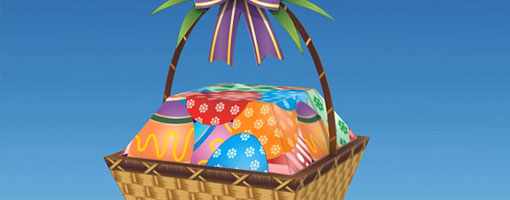
Easter eggs are specially decorated eggs given to celebrate the Easter holiday or springtime. The egg was a symbol of the rebirth of the earth in Pagan celebrations of spring and was adopted by early Christians as a symbol of the rebirth.
The oldest tradition is to use dyed or painted chicken eggs, but a modern custom is to substitute chocolate eggs, or plastic eggs filled with confectionery such as jellybeans. These eggs are often hidden, allegedly by the Easter Bunny, for good children to find on Easter morning. Otherwise, they are generally put in a basket filled with real or artificial straw to resemble a bird's nest. [Wikipedia}
Origin and folklore
The egg is widely used as a symbol of the start of new life, just as new life emerges from an egg when the chick hatches out.
The ancient Persians painted eggs for Nowrooz, their New Year celebration, which falls on the Spring equinox. The Nawrooz tradition has existed for at least 2,500 years. The decorated eggs are one of the core items to be placed on the Haft Seen, the Persian New Year display. The sculptures on the walls of Persepolis show people carrying eggs for Nowrooz to the king.
At the Jewish Passover Seder, a hard-boiled egg dipped in salt water symbolizes the Passover sacrifice offered at the Temple in Jerusalem.
The pre-Christian Saxons had a spring goddess called Eostre, whose feast was held on the Vernal Equinox, around 21 March. Her animal was the spring hare, The Germanic goddess is known from the writings of Bede Venerabilis the seventh-century Benedictine monk. Bede describes the pagan worship of Ēostre among the Anglo-Saxons as having died out before the time he was writing. Bede's De temporum ratione attributes her name to the festival, but does not mention eggs at all.
Some belive Eostre was associated with eggs and hares, and the rebirth of the land in spring was symbolised by the egg. [Wikipedia}

The egg is seen as symbolic of the grave and life renewed or resurrected by breaking out of it. The red supposedly symbolizes the blood of Christ redeeming the world and human redemption through the blood shed in the sacrifice of the crucifixion. The egg itself is a symbol of resurrection: while being dormant it contains a new life sealed within it.
For Orthodox Christians, the Easter egg is much more than a celebration of the ending of the fast, it is a declaration of the Resurrection of Jesus. Traditionally, Orthodox Easter eggs are dyed red to represent the blood of Christ, shed on the Cross, and the hard shell of the egg symbolized the sealed Tomb of Christ—the cracking of which symbolized his resurrection from the dead.
In the Orthodox and Eastern Catholic Churches, Easter eggs are blessed by the priest at the end of the Paschal Vigil, and distributed to the faithful. Each household also brings an Easter basket to church, filled not only with Easter eggs but also with other Paschal foods such as paskha, kulich or Easter breads, and these are blessed by the priest as well.
During Paschaltide, in some traditions the Paschal greeting with the Easter egg is even extended to the deceased. On either the second Monday or Tuesday of Pascha, after a memorial service people bring blessed eggs to the cemetery and bring the joyous paschal greeting, "Christ has risen", to their beloved departed. [Wikipedia}
HAPPY EASTER 2009
Julius (paper-replika.com)
